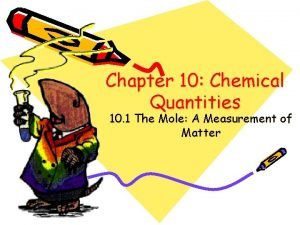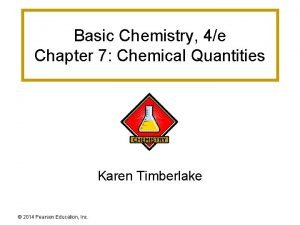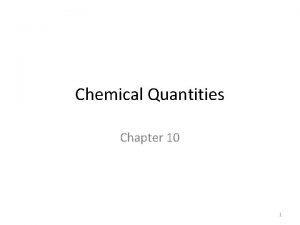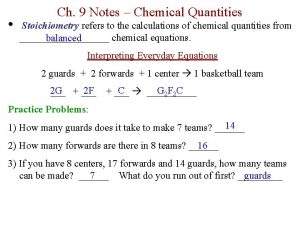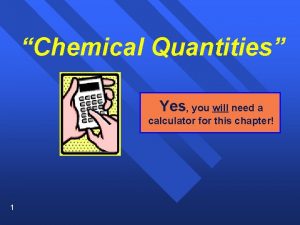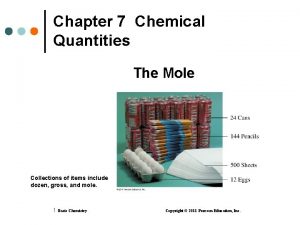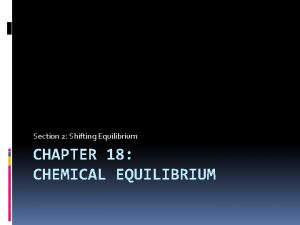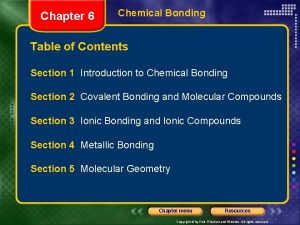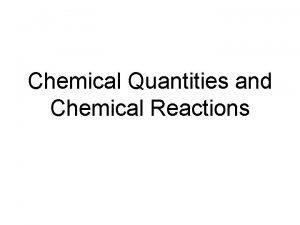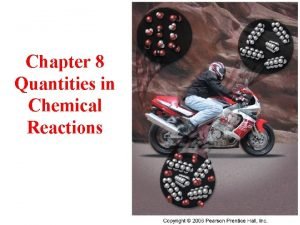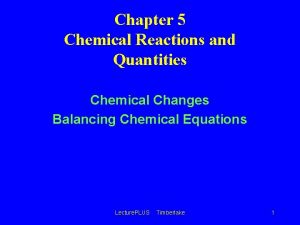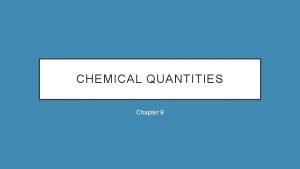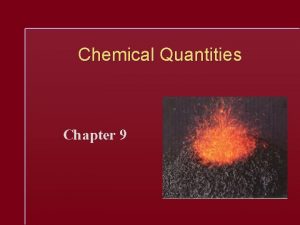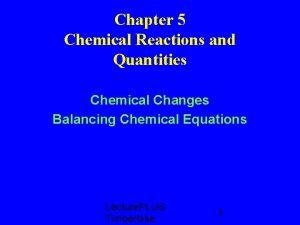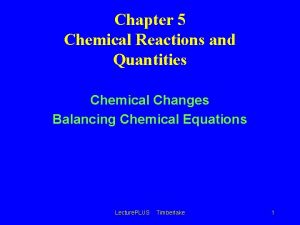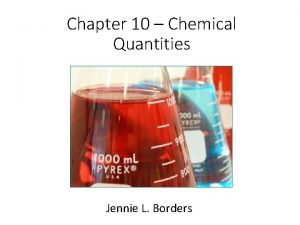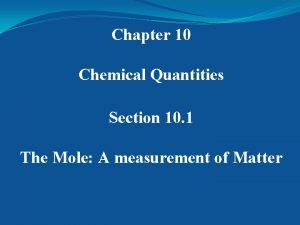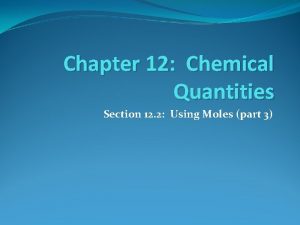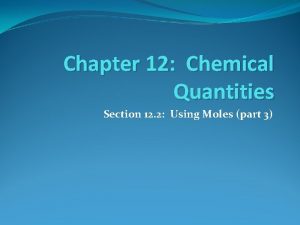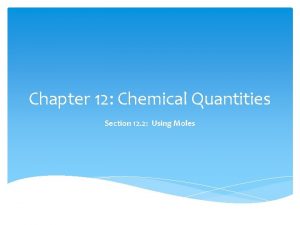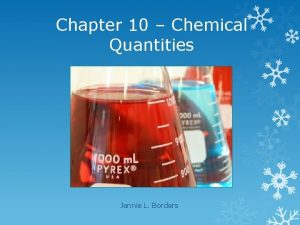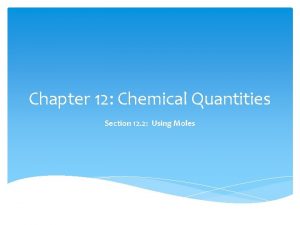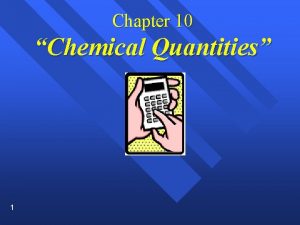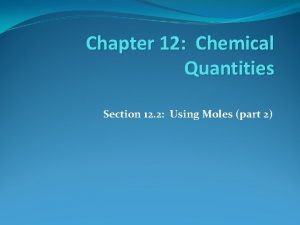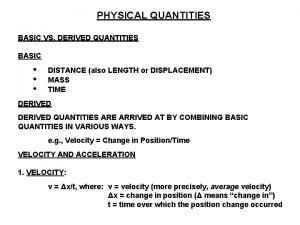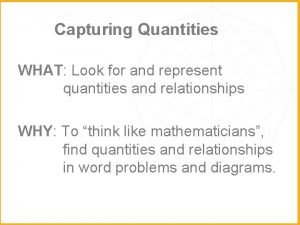CHAPTER 10 CHEMICAL QUANTITIES SECTION 10 1 THE









































- Slides: 41

CHAPTER 10 – CHEMICAL QUANTITIES

SECTION 10. 1 – THE MOLE: A MEASUREMENT OF MATTER • You often measure the amount of something by count, by mass, or by volume. • A mole (mol) of a substance is 6. 02 x 1023 representative particles of that substance. • 6. 02 x 1023 is called Avogadro’s number. 1 mole = 6. 02 x 1023 representative particles

REPRESENTATIVE PARTICLES • A representative particle refers to the species present in a substance: usually atoms, molecules, or ions. • Elements normally exist as atoms, but 7 elements exist as diatomic molecules: H 2, N 2, O 2, F 2, Cl 2, Br 2, and I 2. Be H 2 O Na+

SAMPLE PROBLEM • How many moles is 2. 80 x 1024 atoms of silicon? 4. 65 mol Si

PRACTICE PROBLEMS • How many moles is 2. 17 x 1023 representative particles of bromine? 0. 360 mole Br 2 • How many molecules are in 2. 12 mol of propane? (m/c = molecules) 1. 28 x 1024 m/c C 3 H 8

SAMPLE PROBLEM • How many atoms are in 1. 14 mol SO 3? 2. 75 x 1024 atoms

PRACTICE PROBLEMS • How many moles are in 4. 65 x 1024 molecules of NO 2? 7. 72 mol NO 2 • How many atoms are in 4. 33 mol magnesium sulfate? 1. 564 x 1025 atoms

MOLAR MASS • The atomic mass of an element expressed in grams is the mass of a mole of the element. • The mass of a mole of an element is the molar mass. • To calculate the molar mass of a compound, find the number of grams of each element in one mole of the compound. Then add the masses of the elements in the compound.

SAMPLE PROBLEM • What is the molar mass of PCl 3? 137. 5 g/mol

PRACTICE PROBLEMS • What is the molar mass of sodium hydrogen carbonate? 84 g/mol • What is the mass of calcium nitrate? 164 g/mol

SECTION 10. 1 ASSESSMENT 1. Describe the relationship between Avogadro’s number and one mole of any substance. 2. How can you calculate the mass of a mole of a compound? 3. How many moles is 1. 50 x 1023 molecules NH 3? 0. 249 mol NH 3 4. How many atoms are in 1. 75 mol of CHCl 3? 5. 27 x 1024 atoms 5. What is the molar mass of Ca. SO 4? 136. 2 g/mol

SECTION 10. 2 – MOLE-MASS AND MOLE-VOLUME RELATIONSHIPS • You can use the molar mass of a substance as a conversion factor to convert between moles and mass. 1 mole = molar mass

SAMPLE PROBLEM • What is the mass of 9. 45 mol of alumiunum oxide? 964 g Al 2 O 3

PRACTICE PROBLEMS • Find the mass, in grams, of 4. 52 x 10 -3 mol C 20 H 42. 1. 27 g C 20 H 42 • Calculate the mass of 2. 50 mol of iron (II) hydroxide. 225 g Fe(OH)2 • Calculate the number of moles in 75. 0 g of dinitrogen trioxide. 0. 987 mol N O 2 3

VOLUME • Avogadro’s hypothesis states that equal volumes of gases at the same temperature and pressure contain equal numbers of particles. • At STP, 1 mole of any gas occupies a volume of 22. 4 L. • STP = standard temperature (0 o. C) and pressure (1 atm)

VOLUME • The volume of a gas changes with temperature and pressure, so 22. 4 L can only be used if the gas is at STP. 1 mol = 22. 4 L

SAMPLE PROBLEM • Determine the volume, in liters, of 0. 60 mol of SO 2 gas at STP. 13 L SO 2

PRACTICE PROBLEMS • What is the volume of 3. 70 mol N 2 at STP? 82. 9 L N 2 • How many moles is in 127 L of CO 2 at STP? 5. 67 mol CO 2

MOLE CONVERSION FACTORS • Now you have 3 conversion factors for moles: • 1 mol = 6. 02 x 1023 r. p. (for atoms, m/c, or ions) • 1 mol = molar mass (for grams or mass) • 1 mol = 22. 4 L (for liters or volume)

SECTION 10. 2 ASSESSMENT 1. What is the volume of one mole of any gas at STP? 2. How many grams are in 5. 66 mol of calcium carbonate? 567 g Ca. CO 3 3. Find the number of moles in 508 g of ethanol (C 2 H 5 OH). 11 mol C 2 H 5 OH 4. Calculate the volume, in liters, of 1. 50 mol chlorine at STP. 33. 6 L Cl 2

SECTION 10. 2 ASSESSMENT 5. Three balloons filled with 3 different gaseous compounds each have a volume of 22. 4 L at STP. Would these balloons have the same mass or contain the same number of molecules? Explain.

SECTION 10. 3 – PERCENT COMPOSITION AND CHEMICAL FORMULAS • The percent by mass (percent composition) of an element in a compound is the number of grams of the element divided by the mass in grams of the compound multiplied by 100%. % mass of element = mass of element x 100 mass of compound

SAMPLE PROBLEM • When a 13. 60 g sample of a compound containing only magnesium and oxygen is decomposed, 5. 40 g of oxygen is obtained. What is the percent composition of this compound? Mg = 60. 3% O = 39. 7%

PRACTICE PROBLEMS • A compound formed when 9. 03 g Mg combines completely with 3. 48 g N. What is the percent composition of this compound? Mg = 72. 2%, N = 27. 8% • When a 14. 2 g sample of mercury (II) oxide is decomposed into its elements by heating, 13. 2 g of Hg is obtained. What is the percent composition of this compound? Hg = 93%, O = 7%

PERCENT COMPOSITION • If a percent composition problem does not give you the exact masses of the elements, then you can use the molar masses instead. • Use the same formula for percent composition.

SAMPLE PROBLEM • Calculate the percent composition of propane (C 3 H 8). C = 81. 8% H = 18%

PRACTICE PROBLEMS • Calculate the percent composition of sodium hydrogen sulfate. Na = 19. 2%, H = 0. 83%, S = 26. 7%, O = 53. 3% • Calculate the percent composition of NITROGEN in ammonium nitrate. N = 35%N

CHEMICAL FORMULAS • The molecular formula is the actual formula for a molecular compound. It contains the actual number of each type of atom. • The empirical formula is the lowest whole-number ratio of atoms in a molecular compound. C 6 H 12 O 6 CH 2 O m. f. e. f.

EMPIRICAL FORMULA • Sometimes the empirical formula is the same as the molecular formula. Ex: H 2 O • To calculate the empirical formula, you follow 3 steps: 1. Change % to grams. 2. Convert grams to moles. 3. Divide each number by the smallest answer.

SAMPLE PROBLEM • Calculate the empirical formula for a compound that is 67. 6% Hg, 10. 8% S, and 21. 6% O. Hg. SO 4

PRACTICE PROBLEMS • Calculate the empirical formula for the following: • 94. 1% O and 5. 9% H OH • 62. 1% C, 13. 8% H, and 24. 1% N C 3 H 8 N

EMPIRICAL FORMULA • After step 3, you should get whole numbers that can be used as the subscripts. • Sometimes you will get a number that ends in. 5 or. 33. Do NOT round these numbers. • For. 5, multiply all answers by 2. • For. 33, multiply all answers by 3.

SAMPLE PROBLEM • A compound is analyzed and found to contain 25. 9% nitrogen and 74. 1% oxygen. What is the empirical formula of the compound? N 2 O 5

PRACTICE PROBLEM • Determine the empirical formula for a compound that is 50. 7% C, 4. 2% H, and 45. 1% O. C 3 H 3 O 2

MOLECULAR FORMULA • An empirical and molecular formula differ by a whole -number multiple, so their masses also differ by the same whole-number multiple. m. f. e. f. C 6 H 12 O 6 CH 2 O 180 g/mol 30 g/mol Multiplier = 6

MOLECULAR FORMULA Whole-number multiplier = mass of m. f. mass of e. f.

SAMPLE PROBLEM • Calculate the molecular formula of a compound whose molar mass is 60 g/mol and empirical formula is CH 4 N. C 2 H 8 N 2

PRACTICE PROBLEMS • Find the molecular formula for antifreeze with a molar mass of 62 g/mol and an empirical formula of CH 3 O. C 2 H 6 O 2 • What is the molecular formula for a compound with a molar mass of 90 g/mol and an empirical formula of CH 2 O? C 3 H 6 O 3

SECTION 10. 3 ASSESSMENT 1. How do you calculate the percent by mass of an element in a compound? 2. What information can you obtain from an empirical formula? 3. How is the molecular formula of a compound related to its empirical formula? 4. Calculate the percent composition of calcium acetate. Ca = 25. 4%, C = 30. 4%, H = 3. 8%, O = 40. 5%

SECTION 10. 3 ASSESSMENT 5. The compound methyl butanoate has a percent composition of 58. 8% C, 9. 8% H, and 31. 4% O and its molar mass is 102 g/mol. What is its empirical and molecular formula? e. f. = C 5 H 10 O 2 m. f. = C 5 H 10 O 2 6. Which of the following molecular formulas are also empirical formulas? a. C 5 H 10 O 5 c. C 55 H 72 Mg. N 4 O 5 b. C 6 H 12 O 2 d. C 12 H 17 ON

THE END
 Angular acceleration vs linear acceleration
Angular acceleration vs linear acceleration Label an atom
Label an atom Chemistry chapter 10 chemical quantities
Chemistry chapter 10 chemical quantities Chapter 7 chemical quantities answer key
Chapter 7 chemical quantities answer key Chemical quantities chapter 10
Chemical quantities chapter 10 Chapter 10 chemical quantities practice problems answer key
Chapter 10 chemical quantities practice problems answer key Chapter 9 chemical quantities
Chapter 9 chemical quantities Section 2 reinforcement classifying chemical reactions
Section 2 reinforcement classifying chemical reactions Section 2 reinforcement classifying chemical reactions
Section 2 reinforcement classifying chemical reactions Section 1 chemical changes
Section 1 chemical changes The calculation of quantities in chemical equations
The calculation of quantities in chemical equations The calculation of quantities in chemical equations
The calculation of quantities in chemical equations Chemical quantities calculator
Chemical quantities calculator Unit chemical quantities the mole 1 step
Unit chemical quantities the mole 1 step Empirical formula and molecular formula pogil
Empirical formula and molecular formula pogil Modern chemistry chapter 7 review answers
Modern chemistry chapter 7 review answers Are kc and kp equal
Are kc and kp equal Chapter 18 review chemical equilibrium section 2 answer key
Chapter 18 review chemical equilibrium section 2 answer key Reaction rates and equilibrium worksheet answers chapter 19
Reaction rates and equilibrium worksheet answers chapter 19 Chapter 8 review chemical equations and reactions
Chapter 8 review chemical equations and reactions Chapter 8 section 1 chemical equations and reactions
Chapter 8 section 1 chemical equations and reactions Chapter 6 chemical bonding section 4
Chapter 6 chemical bonding section 4 Physical quantities and units
Physical quantities and units Chapter 10 section 1: meiosis
Chapter 10 section 1: meiosis Hát kết hợp bộ gõ cơ thể
Hát kết hợp bộ gõ cơ thể Frameset trong html5
Frameset trong html5 Bổ thể
Bổ thể Tỉ lệ cơ thể trẻ em
Tỉ lệ cơ thể trẻ em Gấu đi như thế nào
Gấu đi như thế nào Tư thế worms-breton
Tư thế worms-breton Chúa sống lại
Chúa sống lại Các môn thể thao bắt đầu bằng tiếng bóng
Các môn thể thao bắt đầu bằng tiếng bóng Thế nào là hệ số cao nhất
Thế nào là hệ số cao nhất Các châu lục và đại dương trên thế giới
Các châu lục và đại dương trên thế giới Cong thức tính động năng
Cong thức tính động năng Trời xanh đây là của chúng ta thể thơ
Trời xanh đây là của chúng ta thể thơ Mật thư anh em như thể tay chân
Mật thư anh em như thể tay chân Làm thế nào để 102-1=99
Làm thế nào để 102-1=99 độ dài liên kết
độ dài liên kết Các châu lục và đại dương trên thế giới
Các châu lục và đại dương trên thế giới Thơ thất ngôn tứ tuyệt đường luật
Thơ thất ngôn tứ tuyệt đường luật Quá trình desamine hóa có thể tạo ra
Quá trình desamine hóa có thể tạo ra


